- 1College of Geosciences and Engineering, North China University of Water Resources and Electric Power, Zhengzhou, China
- 2Institute of Natural Resource Investigation and Evaluation, Henan Academy of Land and Resources Sciences, Zhengzhou, China
Tight sandstone gas (TSG) reservoirs develop extensively in the upper Paleozoic coal bearing strata in both the southern North China Basin and the Ordos Basin. The former has not achieved important advances in TSG exploration, while the latter has built the largest TSG production facility in China. By comparing the TSG accumulation conditions in the Tongxu area of the southern North China Basin and the Fuxian area of the Ordos Basin, the main controlling factors of TSG accumulation in the southern North China Basin were analyzed in this article. The results indicate that the organic matter type of the upper Paleozoic source rocks are mainly type III kerogen, vitrinite reflectance values (Ro) are greater than 3.1%, source rocks are over mature, and the reservoir strata are characterized by low porosity and extra low permeability; therefore reservoir forming conditions are similar to those of the Ordos Basin. During the Late Jurassic-Early Cretaceous period, after a large-scale generation of hydrocarbons from source rocks in the two basins, the tectonic movements in the Yanshan period controlled the differential accumulation of TSG. The Ordos Basin has been uplifted as a whole by tectonic processes since the Triassic, which allowed a continuous deposition of Triassic strata, thus providing good sealing conditions for the upper Paleozoic TSG reservoirs. The southern North China Basin has experienced multi-stage compressive and extensive tectonic actions, so the original unified Paleozoic basin was divided into several residual blocks. However, the residual thickness of Triassic strata in slopes and sags is higher. The source rocks, reservoir strata, caprocks, and overlying strata continuously deposited in time, and the time allocation of reservoir forming elements is favorable. Therefore, this is conducive to the preservation of TSG reservoirs in the upper Paleozoic. Such reservoirs are defined by high gas saturation and enriched sandstone gas.
Introduction
The Late Paleozoic sequences from the southern North China Basin and the Ordos Basin belong to the North China sedimentary system, which is characterized by a good horizontal comparison of strata and deposition conditions (Yang et al., 2010). The coal-bearing source rocks widely develop in the Late Carboniferous Taiyuan Formation and the Early Permian Shanxi Formation, which provide a resource basis for tight sandstone gas (TSG) reservoirs in the Shihezi Formation and Shanxi Formation. The complete theoretical systems of TSG accumulation have been established in the Ordos Basin, which effectively guide the exploration and development of TSG reservoirs (Fu et al., 2005; Yang et al., 2008; Li et al., 2009a; Zou et al., 2009; Xu et al., 2011; Yang et al., 2012; Zhao et al., 2014; Li et al., 2016; Meng et al., 2016; Wang et al., 2017; Wu et al., 2022). Sandstone gas came from coal bearing strata of the Upper Paleozoic (Wang et al., 2014; Chen et al., 2016; Hao et al., 2016; Dai et al., 2019; Fu et al., 2019; Zou et al., 2019). TSG accumulation mainly occurred in Jurassic Period and Cretaceous Period (Ren et al., 2006; Xie and Zhou, 2006; Yang et al., 2015; Wang et al., 2018). Pressure sealing created efficient storage conditions (Li et al., 2009b; Zhao et al., 2012; Yang et al., 2015). At present, the largest TSG production facility in China has been built in the Ordos Basin. TSG production of the Changqing oilfield reached 323 m3 × 108 m3 in 2020 (He et al., 2021). After more than 60 years of TSG exploration in the upper Paleozoic formations of the southern North China Basin, no substantial breakthrough has been achieved, although some wells have successively obtained gas shows or low-yield gas flow (Zhou, 2010; Zhang et al., 2017).
TSG accumulation conditions in the Tongxu area of the southern North China Basin and the Fuxian area of the Ordos Basin are similar. There are few differences in the development characteristics, types and maturity of source rocks and composition and physical properties of reservoir rocks. In this study, based on the theories of TSG accumulation in the Ordos Basin, main controlling factors of TSG accumulation in the upper Paleozoic of the southern North China basin have been defined through a comprehensive comparative study of the geological conditions in combination with the analysis of oil and gas accumulation processes. Additionally, we suggest favorable exploration directions to provide theoretical supports for the breakthrough of TSG exploration in the southern North China Basin.
Formation conditions of tight sandstone gas reservoir
Tectonic characteristics
The Ordos Basin has experienced multiple episodes of tectonic movements since the Triassic. The strata in the interior of the basin did not suffer obvious fold deformations. The overall structure is stable, and the original configuration of the Paleozoic strata is well preserved. The structural changes in the terminal stage mainly show the general pattern of “Uplift in the eastern part and depression in the western part” (Zhao et al., 2010). The Fuxian area is located in the southern part of the Yishan Slope in the interior of the basin. The tectonic characteristics show the same tectonic pattern and persist in this part of the basin. The main body is a west-dipping slope with an average gradient of about 5 m/km. No significant faults were identified, and the nose-shaped uplift developed with low tectonic amplitude in the Yishan slope.
Initially, the structures of the southern North China Basin had a NW-NWW direction and were primarily controlled by the Qinling-Dabie orogenic belt. Afterwards, they were affected by the Tanlu strike-slip fault system on the east side, superimposing the structures in a NE-NNE direction (Xu et al., 2003). The current structures of the basin are mostly established as a block uplift and block depression tectonic pattern. The Tongxu area is located in the central and northern parts of the southern North China Basin. The main body is an uplift distributed in the NW direction, superimposing with NE broad and gentle anticlines and synclines, and is cut by NWW and NE faults. According to the tectonic characteristics, it can be divided into four tectonic units, including the Tongxu Uplift, the Zhuangtou Slope, the Nancao subsag, and the Gaoxian Subsag (Figure 1). The Paleozoic strata in the western part of the area are widely distributed, while the Triassic strata are predominantly residual in slopes and subsags.
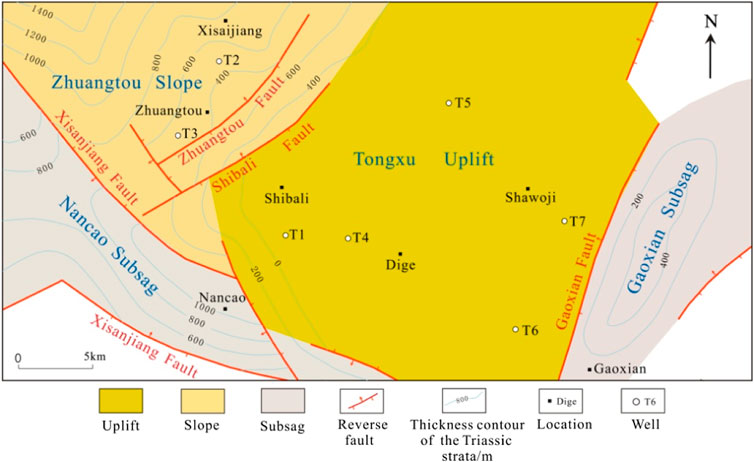
FIGURE 1. Tectonic units and the stratum distribution characteristic of the Triassic strata in the Tongxu area.
Source rocks geochemical characteristics
During the Late Carboniferous—Early Permian, a succession of dark coal-bearing strata characterized by marine—continental transitional facies deposited in North China (Wu et al., 2015), which provided an important source of gas for TSG reservoirs in the upper Paleozoic formations.
The source rocks in the Tongxu area and the Fuxian area consist of coal and dark mudstone, with little difference in quality, thickness, and maturity of the source rocks. By analyzing the kerogen stable carbon isotopes ratio (δ13C) of the source rocks, theδ13C values in both regions are greater than −26‰ (Figure 2A), indicating that the organic matter originates from terrestrial higher plants (Huang et al., 1984). The petrographic analysis of kerogen under transmitted light reveals that 75% of the kerogen micro-components of the mud shale are represented by vitrinite, followed by the sapropelic group, with little content of exinite and no inertinite, while kerogen type is mainly humic. The total organic carbon (TOC) contents of the mudstone from the Tongxu area vary between 0.3% and 4.5% with an average value of 1.5% (Figure 2B), and the cumulative thickness of mudstone strata is 40–60 m. The TOC content of coal varies between 50% and 55%, and the cumulative thickness is between 0 and 5 m. However, the thickness distribution is irregular, which is thick in the northern and western parts, and thin in the southern and eastern parts. The TOC contents of the mudstone from the Fuxian area range between 0.5% and 4.2% with an average value of 1.8% (Figure 2B). The cumulative thickness is 35–50 m.The TOC content of coal is 45%–55%, the cumulative thickness is between 4 and 6 m, and the distribution is relatively stable. Both regions experienced late Triassic tectonic thermal events (Ren et al., 2006; Xie and Zhou, 2006; Wang et al., 2018). The abnormally high geothermal field caused the source rocks to enter the over mature stage. This has been confirmed by the high vitrinite reflectance values (Ro) that are greater than 3.1% (Figure 2C). The Rock-Eval pyrolysis data show that the hydrogen index values in the two areas are generally less than 20 mg/g, and the hydrocarbon generation potential (Pg) is less than 0.4 mg/g (Figure 2D), which indicates that the liquid hydrocarbons in the source rocks have been completely cracked by heating under pressure.
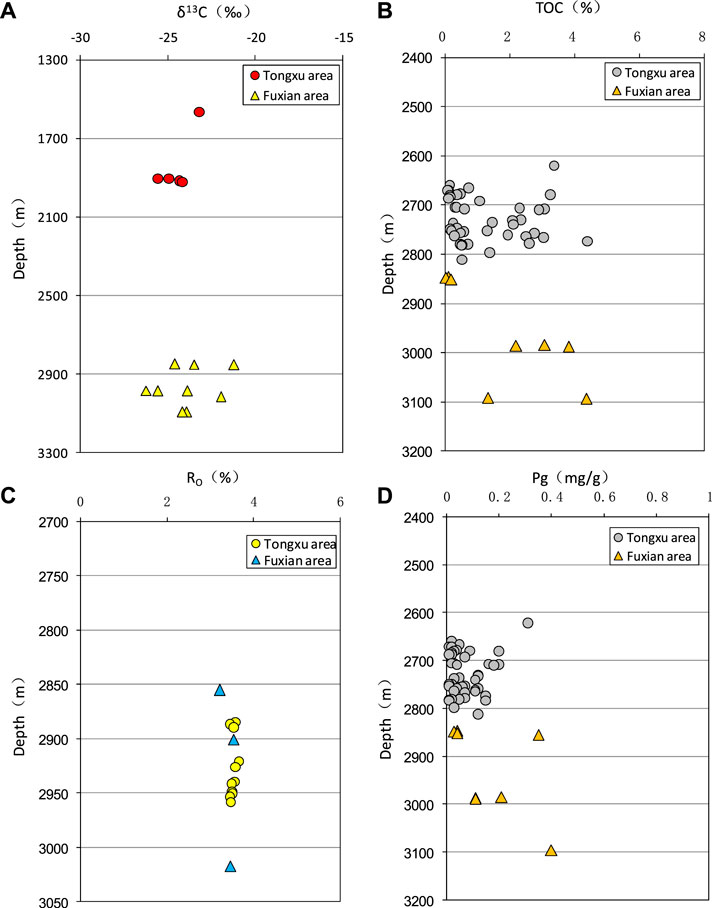
FIGURE 2. Source rocks geochemical characteristics in both the Tongxu area and the Fuxian area, (A) Theδ13C values are greater than −26‰, (B) TOC contents are less than 4.5%, (C) Ro values that are greater than 3.1%, (D) Pg values are less than 0.4 mg/g.
Reservoir properties
The sedimentary environment of the Carboniferous-Permian strata in North China is characterized by marine-continental transitional facies, and distributary channel sand bodies are the most favorable reservoirs. The Fuxian area and the Tongxu area are defined by strong compaction, the sandstones are generally densely cemented, and the thickness of a single layer is usually 3–10 m. The reservoir spaces are dominated by intergranular pores and intragranular dissolved pores, which are characterized by low porosity and extra-low permeability.
The sandstone component comparison in the triangular diagram illustrates that the main reservoirs in the upper Paleozoic strata from the Tongxu area are predominantly medium to fine-grained lithic sandstones (Figure 3A), while the Lower Shihezi Formation contains feldspar lithic sandstones. The quartz content of each section is less than 75%, which generally varies between 61% and 72% with an average value of 64%, while the feldspar content is usually between 0% and 5% with an average value of 2%. The rock debris content ranges between 12% and 43% with an average of 33.5%. The sandstones are poorly to moderately sorted, and the grains are sub-angular with pore-type cementation. Some quartz particles develop secondary enlarged edges, and the particles are in point-line contact. The primary reservoirs in the Fuxian area are medium to fine-grained lithic quartz sandstones, followed by quartz sandstones, and some sections of the Shanxi Formation also consist of lithic sandstone reservoirs (Figure 3B). The quartz content of the Lower Shihezi Formation and Taiyuan Formation is generally higher. It is greater than 75% with an average value of 85%. The contents of feldspar and rock debris are lower, which range between 10% and 25% with an average value of 13%. The sandstone reservoirs of the Shanxi Formation are enriched in rock debris, which can reach up to 30%. Sandstones have medium to good sorting properties. Sandstone particles are sub-angular and sub-rounded, porous cementation, and in point-line contact. The quartz content of the upper Paleozoic sandstones in the Fuxian area is significantly higher in comparison with the sandstones from the Tongxu area. Figure 4 shows that the sandstones of the Lower Shihezi Formation in Fuxian area contain 83% quartzs, the Surface porosity is 1.7%, and intragranular pores and microcracks are visible (Figure 4A); In Tongxu area, the sandstones of the Lower Shihezi Formation contain only 65% quartzs, the Surface porosity is 0.8%, and intragranular dissolved pores are visible (Figure 4B).
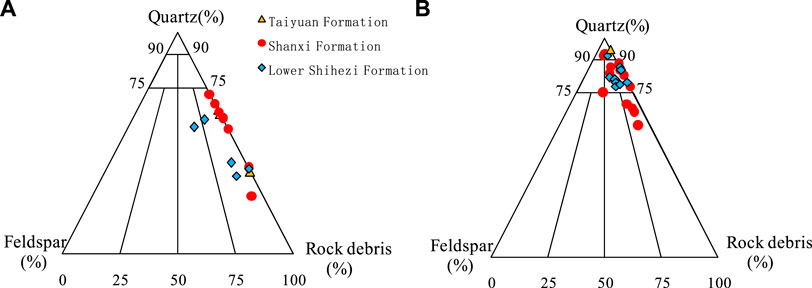
FIGURE 3. The sandstone component comparison in the triangular diagram, (A) The main reservoirs from the Tongxu area are predominantly lithic sandstones, (B) The quartz content in the Fuxian area is significantly higher.
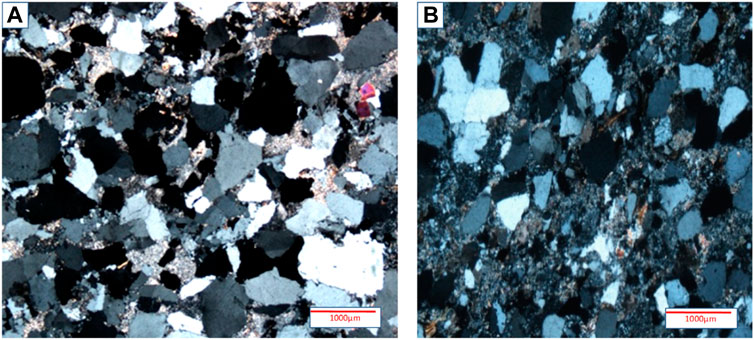
FIGURE 4. Identification characteristics of sandstone slice image [×2 (+)], (A) In Fuxian area, the sandstone of the Lower Shihezi Formation contains 83% quartz, intragranular pores and microcracks are visible, (B) In Tongxu area, the sandstone of the Lower Shihezi Formation contains only 65% quartz, intragranular dissolved pores are visible.
The pore permeability of the upper Paleozoic sandstone reservoir in the Fuxian area is slightly better than in the Tongxu area. The average reservoir porosity and permeability of the former are 5.2% and 0.19 mD, respectively, and those of the latter are 4.6% and 0.19 mD, respectively. It might be an important argument for the difference in the physical properties of the upper Paleozoic reservoirs in these two areas (Zheng and Hu, 2006).
Caprock properties
The original structure of the Paleozoic strata in the Ordos Basin is well preserved. Thus, several sets of lacustrine and swamp facies argillaceous cap rocks are developed, as well as multiple sets of caprocks are vertically superimposed. The Triassic Triassic, Jurassic, and Cretaceous strata in the interior of the basin are characterized by continuous deposition and large thicknesses. They cover the Paleozoic formations parallel to the bedding surfaces, which provide exceptional sealing conditions for the Paleozoic gas reservoirs.
The characteristics of the upper Paleozoic caprocks in the southern North China Basin are similar to those in the Ordos Basin, and multiple sets of mudstone and coal-bearing caprocks overlie the upper Paleozoic strata. The cumulative thickness in the Tongxu area is 80–150 m, of which the thicknesses of the mudstone and coal layers are 20–50 m and 2–6 m, respectively. A set of thick mudstones developed in the upper Shihezi Formation, which can be considered a regional caprock. These characteristics are slightly better in comparison with the Fuxian area. Consequently, it is beneficial to the preservation of gas reservoirs during stable tectonic periods. Due to the multi-stage tectonic actions of Triassic and Cenozoic extrusion-strike-slip-extension, this region has been strongly reorganized tectonically. The overlying Triassic and even Permian strata have been denuded to varying degrees, therefore forming, or damaging the previous gas sealing system, and some or all gas reservoirs have been destroyed. In the Tongxu uplift area, the Triassic strata are completely denuded, while in the subsag and slope zones, the Triassic strata are relatively thick. In Nancao subsag, the thickness of the Triassic strata is the highest, with the maximum thickness exceeding 1,000 m, which is conducive to the preservation of TSG reservoirs in the Upper Paleozoic (Figure 1).
Controlling factors of gas accumulation
By comparing the TSG accumulation conditions (Table 1) and events (Figure 5) in the Tongxu area of the southern North China Basin and the Fuxian area of the Ordos Basin, the main controlling factors of TSG accumulation in the southern North China Basin have been analyzed.

TABLE 1. Comparing the TSG accumulation conditions in the Tongxu area of the Southern North China basin and the Fuxian area of the Ordos basin.
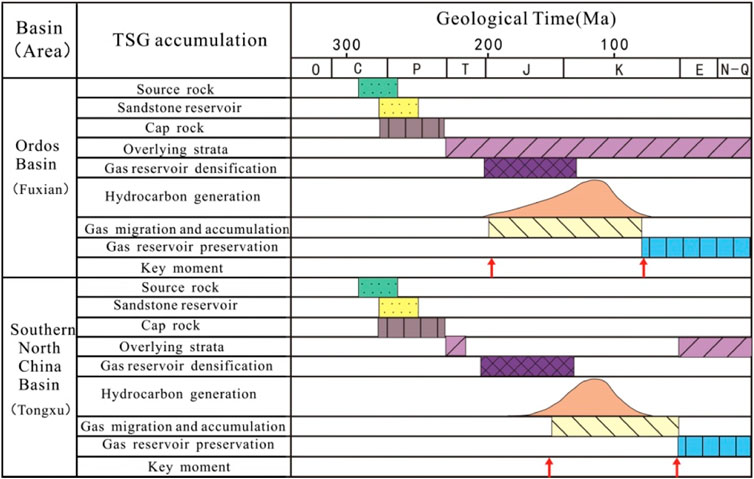
FIGURE 5. The comparison of TSG accumulation events. The southern North China Basin has distinct differences in the underlying Carboniferous-Permian TSG reservoirs due to the thicknesses of the Triassic strata.
In the Ordos Basin, the upper Paleozoic source rocks experienced early gas generation in the early Triassic. The gas gradually migrated into the adjacent sandstone reservoirs, which was extremely favorable for the preservation of pores before the reservoirs increased (Zheng and Hu, 2006). Due to the tectonic thermal events in the Early Jurassic-Late Cretaceous, the source rocks entered the over mature window (Ren et al., 2006; Xie and Zhou, 2006; Wang et al., 2018), and enormous quantities of gases were generated. Although the interior structure of the basin was affected by the Yanshan tectonic movement and experienced tectonic uplift, the lateral adjustments were not powerful. They were characterized only by an overall monoclinic rise and fall, and the faults did not develop. Additionally, the upper Triassic strata were missing locally, while the upper Paleozoic strata were not affected by denudation. The temporal continuity of deposition in reservoirs, caprocks, and overlying strata was consistent without obvious damage to the upper Paleozoic gas reservoirs. Due to the stable thickness of the overlying strata and good preservation conditions in the Carboniferous-Permian TSG reservoir, the gas saturation of the gas reservoirs is high, with values between 40% and 50% (Figure 6).
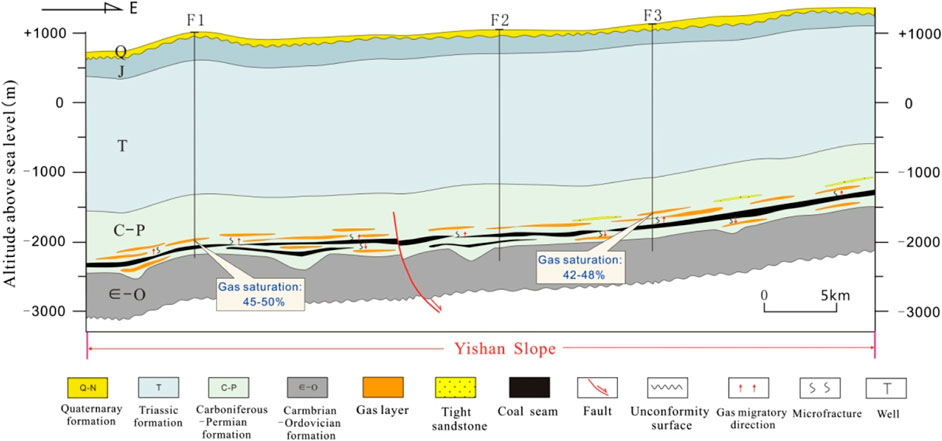
FIGURE 6. The TSG reservoir section in the Fuxian area of the Ordos Basin. Due to the stable thickness of the overlying strata and less faults, the gas saturation of the gas reservoirs is high.
The large-scale gas generation in the Tongxu area of the southern North China Basin also occurred during the Early Jurassic-Late Cretaceous when the porosity of the upper Paleozoic sandstone reservoirs decreased (Zhou, 2010). With the occurrence of the Yanshan Movement, this area was continuously squeezed and stretched, the strata were significantly uplifted, and the local differential rises and falls were substantial. In the uplift zones, the Triassic strata were denuded to varying degrees, and even the upper Permian strata were partially eroded, resulting in discontinuities between the source rocks, the reservoirs, the caprocks and the overlying strata. Therefore, the generated gas partially or completely migrated to the surface, and the gas saturation of the underlying Carboniferous-Permian TSG reservoir is low, with values ranging between 10% and 20%. In the subsags and slope zones, the Triassic strata remained relatively intact, and the depositional continuity of the source rocks, the reservoirs, the caprocks and the overlying strata was good, which was favorable for gas accumulation. Thus, the gas saturation of the TSG reservoirs in the underlying Carboniferous-Permian strata is high, ranging between 40% and 45% (Figure 7).
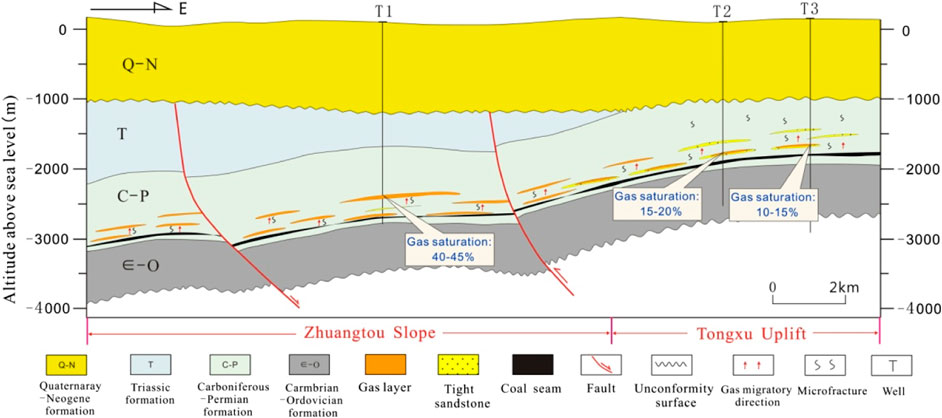
FIGURE 7. The TSG reservoir section in the southern North China Basin. The gas saturation values of the TSG reservoirs varied with the thickness of the Triassic strata.
In conclusion, the southern North China Basin has distinct differences in the underlying Carboniferous-Permian TSG reservoirs due to the influence of the Yanshan tectonic movement. The main factors controlling the enrichment of gas reservoirs are the distribution characteristics of the overlying Triassic strata. Specifically, the areas with greater thicknesses of the Triassic strata were favorable for TSG reservoirs.
Conclusion
The geochemical characteristics, distribution of the source rocks and composition, porosity, and permeability of the sandstone reservoirs in the upper Paleozoic strata of the southern North China Basin are similar to those of the Ordos Basin, which have the basic conditions for TSG accumulation.
The comparative analysis of the gas accumulation process indicates that the main controlling factor for upper Paleozoic TSG accumulation in the Tongxu area of the southern North China Basin is the preservation condition. The Triassic strata in slopes and subsags are relatively thick and well preserved. Additionally, the time allocation for TSG accumulation is good because the source rocks, the reservoirs, the caprocks and the overlying strata have continuity in slopes and subsags.
Data availability statement
The original contributions presented in the study are included in the article/supplementary material, further inquiries can be directed to the corresponding author.
Author contributions
JC designed the study and wrote the manuscript. HZ and HC analyzed the data. QW reviewed the manuscript. All authors contributed to the article and approved the submitted version.
Funding
This study was jointly supported by Natural Science Foundation of Henan Province (Grant No. 202300410278), the Start Project of High Level Researchers of North China University of Water Resources and Electric Power (No. 40758) and Henan Geologica Survey (Projects YZRZ201922 and YGTZ201646).
Acknowledgments
Prof. Wang Feiyu from State Key Laboratory of Petroleum Resources and Prospecting, China University of Petroleum (Beijing), is thanked for helping us to improve this manuscript with his insightful suggestions.
Conflict of interest
The authors declare that the research was conducted in the absence of any commercial or financial relationships that could be construed as a potential conflict of interest.
Publisher’s note
All claims expressed in this article are solely those of the authors and do not necessarily represent those of their affiliated organizations, or those of the publisher, the editors and the reviewers. Any product that may be evaluated in this article, or claim that may be made by its manufacturer, is not guaranteed or endorsed by the publisher.
References
Chen, J. Y., Jia, H. C., Li, Y. J., An, C., Li, W., and Liu, S. H. (2016). Origin and source of natural gas in the upper paleozoic of the yimeng uplift, Ordos basin. Oil Gas Geol. 37, 205–209. doi:10.11743/ogg20160208
Dai, J. X., Qin, S. F., Hu, G. Y., Ni, Y. Y., Gan, L. D., Huang, S. P., et al. (2019). Major progress in the natural gas exploration and development in the past seven decades in China. Petroleum Explor. Dev. 46, 1100–1110. doi:10.1016/s1876-3804(19)60266-1
Fu, J. H., Wei, X. S., and Huang, D. J. (2005). Law of reservoir formulation and exploration techniques of natural gas lithologic reservoir in Ordos Basin. J. Oil Gas Technol. 27, 137–141. CNKI:SUN:JHSX.0.2005-S1-001.
Fu, J. H., Wei, X. S., Luo, S. S., Zuo, Z. F., Zhou, H., Liu, B. X., et al. (2019). Discovery and geological knowledge of the large deep coal-formed qingyang gas field, Ordos basin, NW China. Petroleum Explor. Dev. 46, 1111–1126. doi:10.1016/s1876-3804(19)60267-3
Hao, S. M., Li, L., Zhang, W., Qi, Rong., Ma, C., and Chen, J. Y. (2016). Forming conditions of large-scale gas fields in Permo-Carboniferous in the northern Ordos Basin. Oil Gas Geol. 37, 149–154. doi:10.11743/ogg20160201
He, J. C., Yu, H. J., He, G. H., Zhang, J., and Li, Y. (2021). Natural gas development prospect in Changqing gas rovince of the Ordos Basin. Nat. Gas. Ind. 41, 23–32. doi:10.3787/j.issn.1000-0976.2021.08.003
Huang, D. F., Li, J. C., and Zhang, D. J. (1984). Kerogen types and study on effectiveness, limitation and interrelation of their identification parameters. Acta Sedimentol. Sin. 3, 18–33. CNKI: SUN: CJXB.0.1984-03-001.
Li, Y., Tang, D. Z., Wu, P., Niu, X. L., Wang, K., Qiao, P., et al. (2016). Continuous unconventional natural gas accumulations of Carboniferous-Permian coal-bearing strata in the Linxing area, northeastern Ordos basin, China. J. Nat. Gas Sci. Eng. 36, 314–327. doi:10.1016/j.jngse.2016.10.037
Li, Z. D., Hao, S. M., Li, L., Xi, K. Y., and Guo, M. (2009b). Comparison between the Upper Paleozoic gas reservoirs in Ordos Basin and deep basin gas reservoirs. Oil Gas Geol. 30, 149–155. doi:10.11743/ogg20090204
Li, Z. D., Hao, S. M., Xi, K. Y., Li, L., and Guo, M. (2009a). Discussion on relation of gas accumulation mechanism between deep basin and Upper Paleozoic in the Ordos Basin. Mineralogy Petrology 29, 86–92. doi:10.19719/j.cnki.1001-6872.2009.01.014
Meng, D. W., Jia, A. L., Ji, G., and He, D. B. (2016). Water and gas distribution and its controlling factors of large scale tight sand gas fields: A case study of Western sulige gas field, Ordos basin, NW China. Petroleum Explor. Dev. 43, 663–671. doi:10.1016/s1876-3804(16)30077-5
Ren, Z. L., Zhang, S., Gao, S. L., Cui, J. P., and Liu, X. S. (2006). Research on region of maturation anomaly and formation time in Ordos basin. Acta Geol. Sin. 80, 675–684. doi:10.3321/j.issn:0001-5717.2006.05.006
Wang, L. Z., Wang, L. Y., Peng, P. A., Dai, T. M., and Liu, D. Y. (2018). A thermal event in the Ordos basin: Insights from illite 40Ar-39Ar dating with regression analysis. J. Earth Sci. 29, 629–638. doi:10.1007/s12583-017-0903-7
Wang, M., Tang, H. M., Zhao, F., Liu, S., Yang, Y., Zhang, L. H., et al. (2017). Controlling factor analysis and prediction of the quality of tight sandstone reservoirs: A case study of the He8 member in the eastern sulige gas field, Ordos basin, China. J. Nat. Gas Sci. Eng. 46, 680–698. doi:10.1016/j.jngse.2017.08.033
Wang, T. B., Dong, L., and Zhang, Y. W. (2014). Distribution of large and giant coal-related gas fields in China and its significance. Oil Gas Geol. 35, 167–182. doi:10.11743/ogg20140201
Wu, W. T., Zhao, J. Z., Wang, Y. Z., Guo, M. Q., Wu, H. Y., Li, J., et al. (2022). Main controlling factors and enrichment model of a multi layer tight sandstone gas reservoir: Case study from the linxing gas field, eastern Ordos basin, northern China. Arab. J. Geosci. 15, 1313. doi:10.1007/s12517-022-10596-3
Wu, W., W, Y. H., Cao, G. S., Huang, X. F., and Liu, W. Q. (2015). The geochemical characteristics of the carboniferous and permian source rocks in the western henan, southern North China basin. Nat. Gas. Geosci. 26, 128–136. doi:10.11764/j.issn.1672-1926.2015.01.0128
Xie, D. N., and Zhou, L. F. (2006). Discussion on hydrocarbon generation potential and secondary hydrocarbon generation of organic matter from Permo-Carboniferous coal measures in the southern North China. Coal Geol. Explor. 34, 20–33. doi:10.3969/j.issn.1001-1986.2006.01.009
Xu, H. L., Zhao, Z. J., Yang, Y. N., and Tang, Z. W. (2003). Structural pattern and structural style of the southern North China basin. Acta Geosci. Sin. 24, 27–33. doi:10.3321/j.issn:1006-3021.2003.01.005
Xu, H., Tang, D. Z., Zhang, J. F., Yin, W., Zhang, W. Z., and Lin, W. J. (2011). Factors affecting the development of the pressure differential in Upper Paleozoic gas reservoirs in the Sulige and Yulin areas of the Ordos Basin, China. Int. J. Coal Geol. 85, 103–111. doi:10.1016/j.coal.2010.10.005
Yang, F., Zhou, X. J., and Ni, C. H. (2010). Analysis paleozoic reservoir preservation in the north China. Petroleum Geol. Exp. 32, 527–531. doi:10.11781/sysydz201006527
Yang, H., Fu, J. H., Liu, X. S., and Meng, P. L. (2012). Accumulation conditions and exploration and development of tight gas in the Upper Paleozoic of the Ordos Basin. Petroleum Explor. Dev. 39, 315–324. doi:10.1016/S1876-3804(12)60047-0
Yang, H., Fu, J. H., Wei, X. S., and Liu, X. S. (2008). Sulige field in the Ordos Basin: Geological setting, field discovery and tight gas reservoirs. Mar. Petroleum Geol. 25, 387–400. doi:10.1016/j.marpetgeo.2008.01.007
Yang, H., Liu, X. S., Yan, X. X., and Zhang, H. (2015). The shenmu gas field in the Ordos basin: Its discovery and reservoir-forming geological characteristics. Nat. Gas. Ind. 35, 1–13. doi:10.3787/j.issn.1000-0976.2015.06.001
Zhang, J. D., Zeng, Q. N., Zhou, X. G., Liu, X. F., Zhang, H. D., Wang, Y. F., et al. (2017). Drilling achievements and gas accumulation in the upper paleozoic in Western new area of taikang uplift, southern North China basin. Nat. Gas. Geosci. 28, 1637–1649. doi:10.11764/j.issn.1672-1926.2017.09.004
Zhao, J. Z., Bai, Y. B., Cao, Q., and Er, C. (2012). Quasi-continuous hydrocarbon accumulation: A new pattern for large tight sand oilfields in the Ordos basin. Oil Gas Geol. 33, 811–827. doi:10.11743/ogg20120601
Zhao, J. Z., Wang, L., Sun, B. H., Bai, Y. B., and Wu, W. T. (2010). Effect of structural evolution on formation and distribution of Upper Paleozoic giant gas fields in the East Ordos Basin. Nat. Gas. Geosci. 21, 875–881. doi:10.11764/j.issn.1672-1926.2010.06.875
Zhao, J. Z., Zhang, W. Z., Li, J., Cao, Q., and Fan, Y. F. (2014). Genesis of tight sand gas in the Ordos Basin, China. Org. Geochem. 74, 76–84. doi:10.1016/j.orggeochem.2014.03.006
Zheng, H. R., and Hu, Z. Q. (2006). Gas pool forming conditions for bohai bay basin and Ordos basin in the upper paleozoic. Acta Pet. Sin. 27, 1–5. CNKI:SUN:SYXB.0.2006-03-000.
Zhou, X. J. (2010). Analysis of hydrocarbon accumulation conditions of the Upper Palaeozoic sequence of the southern North China basin. Petroleum Geol. Exp. 32, 420–427. doi:10.11781/sysydz201005420
Zou, C. N., Tao, S. Z., Yuan, X. J., Zhu, R. K., Hou, L. H., Wang, L., et al. (2009). The formation conditions and distribution characteristics of continuous petroleum accumulations. Acta Pet. Sin. 30, 324–331. doi:10.7623/syxb2009002
Keywords: tight sandstone, resource rock, reservoir, accumulation, southern North China Basin, Ordos Basin
Citation: Chen J, Zhang H, Chang H and Wang Q (2023) Research on main controlling factors of tight sandstone gas accumulation in coal-bearing strata in the southern North China Basin: Comparison with the Ordos Basin. Front. Earth Sci. 10:1037658. doi: 10.3389/feart.2022.1037658
Received: 06 September 2022; Accepted: 29 September 2022;
Published: 04 January 2023.
Edited by:
Junjian Zhang, Shandong University of Science and Technology, ChinaReviewed by:
Hong Pang, China University of Petroleum, Beijing, ChinaYuehan Yan, Henan Polytechnic University, China
Copyright © 2023 Chen, Zhang, Chang and Wang. This is an open-access article distributed under the terms of the Creative Commons Attribution License (CC BY). The use, distribution or reproduction in other forums is permitted, provided the original author(s) and the copyright owner(s) are credited and that the original publication in this journal is cited, in accordance with accepted academic practice. No use, distribution or reproduction is permitted which does not comply with these terms.
*Correspondence: Jingyi Chen, Q2hlbmppbmd5aUBuY3d1LmVkdS5jbg==
 Jingyi Chen
Jingyi Chen Hongwei Zhang2
Hongwei Zhang2 Qingwei Wang
Qingwei Wang